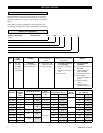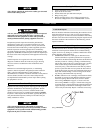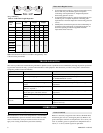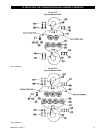
12 MHD56012 - Edition 8
8. Install hand chain (46) in handwheel (31). Make sure hand
chain (46) is seated properly.
9. Install “looped” end of a hand chain guide (35) over each of
the two upper stay bolts on side plate 1 (1). Hand chain
guides (35) must be positioned like two “Ls” pointing inward
(“[_ _]”).
10. Place wheel cover (38) over stay bolts. Free ends of chain
guides (35) go on outside of wheel cover (38).
11. Install U-nuts (40).
Gears (14)
On 1-1/2, 3, 5, 8, 10, 15 and 20 ton units, each hoist body must
have one gear without a “circle” and one gear with a “circle.” The
1/2, 1 and 2 ton units do not use gears with a circle. Refer to Dwg.
MHP0044 on page 12.
(Dwg. MHP0044)
Note: The 1/2 ton hoist has a center pinion gear with only five
teeth.
Hand Chain Adjustment or Replacement
• When cutting weld side of a hand chain link, do not cut or
nick opposite side. A damaged link must be replaced to
prevent premature failure. A falling hand chain can cause
injury.
(Dwg. MHP0016)
1. To create a “C” link, cut welded side of link with a hacksaw.
Clamp one side of “C” link in a vise and bend it open by
using a pliers to grip the exposed part of link. Refer to Dwgs.
MHP0014 and MHP0016 on page 12.
(Dwg. MHP0014)
2. If you are replacing the hand chain, disconnect it at the “C”
link and carefully remove the hand chain.
3. When replacing a hand chain, cut a length 2 times the
required hand chain drop plus about one foot (305 mm). For
adjustments, remove or add a length of chain twice the
difference in hand chain height. To prevent hand chain from
twisting, maintain an even number of links, by removing or
adding an even number of links.
4. If you are replacing hand chain, run new hand chain up
through left hand chain guide, around handwheel, making
sure hand chain is seated in handwheel pockets, and back
down through right hand chain guide.
5. Connect hand chain ends with ‘C’ link(s), making total
number of links even, and bend ‘C’ link(s) shut.
6. Make sure hand chain is not twisted. If twisted, untwist or
open a ‘C’ link and remove one hand chain link if necessary.
Overload Clutch Assembly
1. Install supporter (78) on pinion shaft (13). Set cone wheel
(79) in handwheel (31). Install spring (94) and ball (93) in
hole in handwheel. Position parts on supporter (78) making
sure ball and spring remain in place. Notch in supporter must
line up with ball and spring hole.
2. Install cone spring (80) with dished surface towards brake
discs (27) and (28).
3. Install washer (81) on hub of supporter (78) so tab locates in
supporter slot. Outer tabs on washer (81) must face outward
away from cone spring (80).
4. Install nut (82) on supporter (78) until finger tight.
5. Install washer (32) and nut (33) on pinion shaft (13).
6. Adjust overload clutch as described in the “Overload Clutch
Adjustment” section.
Load Test
Prior to initial use, all new, extensively repaired, or altered hoists
shall be load tested by or under the direction of a person trained in
operation and maintenance of this hoist, and a written report
furnished confirming rating of hoist. Test hoist to 125% of rated
hoist capacity. Testing to more than 125% is required to test
overload clutch and may be necessary to comply with standards
and regulations set forth in areas outside of the USA.


















